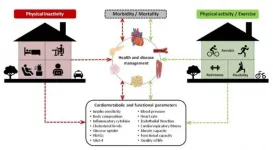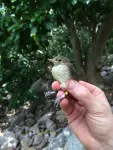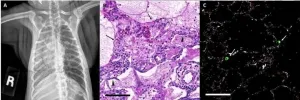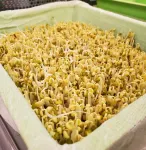Lack of physical exercise during COVID-19 confinement may lead to a rise in mortality
In a review article published in Frontiers of Endocrinology, Brazilian researchers estimate a reduction of 35% in levels of physical activity and a rise of 28% in sedentary behavior in the initial months of confinement imposed by the pandemic
2021-01-19
(Press-News.org) Social distancing and working from home help prevent transmission of the novel coronavirus but can be conducive to unhealthy behavior such as bingeing on fast food or spending more time in a chair or on a couch staring at a screen, and generally moving about less during the day. Scientists believe the reduction in physical activity experienced during the first few months of the pandemic could lead to an annual increase of more than 11.1 million in new cases of type 2 diabetes and result in more than 1.7 million deaths.
The estimates are presented by researchers at São Paulo State University (UNESP), Brazil, in a review article published in Frontiers in Endocrinology. The authors stress that there is an "urgent need" to recommend physical activity during the pandemic.
"Recent studies have shown that people with diabetes face a higher risk of developing the severe form of COVID-19, and of dying if the condition is not properly controlled. Others have shown that social distancing and confinement have considerably reduced levels of physical activity, increased sedentary behavior and lowered the quality of people's nutrition. Our article serves as a warning about the harmful consequences of these trends," said Emmanuel Gomes Ciolac, a professor at UNESP's Department of Physical Education in Bauru, and principal investigator for the study.
The first author of the article is Isabela Roque Marçal, who is studying for a master's degree at UNESP. She was previously a research intern at the University of Leuven, Belgium, with a scholarship from FAPESP.
Among other data sources, the review covers the findings of an international online survey conducted by a group of 35 research institutions on several continents. According to the results, which are preliminary in that they refer to the first 1,000 volunteers to complete the questionnaire, the level of physical activity decreased 35% in the initial months of confinement, and this was accompanied by a 28.6% increase in sedentary behavior, such as sitting or lying for long periods, and unhealthy eating. Previous studies had already shown that a lack of physical activity helped cause some 33 million cases of type 2 diabetes in 2019 and 5.3 million deaths in 2018.
Based on data for the period before the pandemic, the researchers estimated that the current prevalence of physical inactivity (not getting the minimum amount of exercise recommended by health authorities) was 57.3% among over-forties generally and 57.7% among people at risk for diabetes, so that a lack of exercise can be considered responsible for 9.6% of diabetes cases (11.1 million) and 12.5% of all-cause deaths worldwide (1.7 million) if this prevalence persists for a long time.
Exercising at home
"It's important to be aware of the difference between insufficient levels of physical activity and sedentary behavior," Ciolac said. "An insufficiently active person is an individual who doesn't get the minimum amount of exercise recommended by the World Health Organization." The WHO recommends at least 150 minutes of moderate aerobic exercise or 75 minutes of vigorous aerobic exercise per week for adults aged 18-64.
Sedentary behavior, he continued, is associated with the time spent sitting, reclining or lying down. Research shows that watching television or working at a computer for long hours can be bad for the health of even physically active people. Those who are required to use a computer all day for their work should get up every 30 minutes or so to stretch their legs and get whatever light exercise is possible.
Confinement should not prevent people from performing more intense physical activity. The WHO's recommendations, for example, include taking online exercise classes, many of which are free of charge, playing with children, doing household chores such as cleaning and gardening, going up and down stairs, even walking on the spot.
The UNESP group also recommend exercises using body weight to improve muscle tone, such as situps, pushups, squatting, and standing up from a chair, as well as aerobic exercises that can safely be performed near the home, such as walking, jogging and cycling. Meals should be as healthy as possible, with plenty of vegetables and fruit, avoiding processed foods.
INFORMATION:
About São Paulo Research Foundation (FAPESP)
The São Paulo Research Foundation (FAPESP) is a public institution with the mission of supporting scientific research in all fields of knowledge by awarding scholarships, fellowships and grants to investigators linked with higher education and research institutions in the State of São Paulo, Brazil. FAPESP is aware that the very best research can only be done by working with the best researchers internationally. Therefore, it has established partnerships with funding agencies, higher education, private companies, and research organizations in other countries known for the quality of their research and has been encouraging scientists funded by its grants to further develop their international collaboration. You can learn more about FAPESP at http://www.fapesp.br/en and visit FAPESP news agency at http://www.agencia.fapesp.br/en to keep updated with the latest scientific breakthroughs FAPESP helps achieve through its many programs, awards and research centers. You may also subscribe to FAPESP news agency at http://agencia.fapesp.br/subscribe.
[Attachments] See images for this press release:

ELSE PRESS RELEASES FROM THIS DATE:
2021-01-19
Just how close are the world's countries to achieving the Paris Agreement target of keeping climate change limited to a 1.5°C increase above pre-industrial levels?
It's a tricky question with a complex answer. One approach is to use the remaining carbon budget to gauge how many more tonnes of carbon dioxide we can still emit and have a chance of staying under the target laid out by the 2015 international accord. However, estimates of the remaining carbon budget have varied considerably in previous studies because of inconsistent approaches and assumptions used by researchers.
Nature Communications Earth and Environment just published a paper by a group of researchers led by Damon Matthews, professor in the Department of Geography, Planning and Environment. In it, ...
2021-01-19
TAMPA, Fla. - Cells need energy to survive and thrive. Generally, if oxygen is available, cells will oxidize glucose to carbon dioxide, which is very efficient, much like burning gasoline in your car. However, even in the presence of adequate oxygen, many malignant cells choose instead to ferment glucose to lactic acid, which is a much less efficient process. This metabolic adaptation is referred to as the Warburg Effect, as it was first described by Otto Warburg almost a century ago. Ever since, the conditions that would evolutionarily select for cells to exhibit a Warburg Effect have been in debate, as it is much less efficient and produces toxic waste ...
2021-01-19
In a new paper published today in the Proceedings of the National Academies of ScienceS (PNAS), planetary geologist Joe Levy, assistant professor of geology at Colgate University, reveals a groundbreaking new analysis of the mysterious glaciers of Mars.
On Earth, glaciers covered wide swaths of the planet during the last Ice Age, which reached its peak about 20,000 years ago, before receding to the poles and leaving behind the rocks they pushed behind. On Mars, however, the glaciers never left, remaining frozen on the Red Planet's cold surface for more than 300 million years, covered in debris. "All the rocks and sand carried on that ice have remained ...
2021-01-19
ATLANTA--Early in the U.S. COVID-19 pandemic, unemployment claims were largely driven by state shutdown orders and the nature of a state's economy and not by the virus, according a new article by Georgia State University economists.
David Sjoquist and Laura Wheeler found no evidence the Payroll Protection Program (PPP) affected the number of initial claims during the first six weeks of the pandemic.
Their research explores state differences in the magnitude of weekly unemployment insurance claims for the weeks ending March 14 through April 25 by focusing on three factors: the impact of COVID-19, the effects of state economic structures and state orders closing non-essential ...
2021-01-19
The offspring of older animals often have a lower chance of survival because the parents are unable to take care of their young as well as they should. The Seychelles warbler is a cooperatively breeding bird species, meaning that parents often receive help from other birds when raising their offspring. A study led by biologists from the University of Groningen shows that the offspring of older females have better prospects when they are surrounded by helpers. This impact of social behaviour on reproductive success is described in a paper that was published ...
2021-01-19
Philadelphia, January 19, 2021 - Aged, wild-caught African green monkeys exposed to the SARS-CoV-2 virus developed acute respiratory distress syndrome (ARDS) with clinical symptoms similar to those observed in the most serious human cases of COVID-19, report researchers in The American Journal of Pathology, published by Elsevier. This is the first study to show that African green monkeys can develop severe clinical disease after SARS-CoV-2 infection, suggesting that they may be useful models for the study of COVID-19 in humans.
"Animal models greatly enhance our understanding of diseases. The lack of an animal model for severe manifestations of COVID-19 has hampered our understanding of this form of the disease," explained lead investigator Robert V. Blair, DVM, PhD, ...
2021-01-19
ATLANTA--Georgia State University biology researchers have found that infecting the nasal passages of mice with the virus that causes COVID-19 led to a rapid, escalating attack on the brain that triggered severe illness, even after the lungs were successfully clearing themselves of the virus.
Assistant professor Mukesh Kumar, the study's lead researcher, said the findings have implications for understanding the wide range in symptoms and severity of illness among humans who are infected by SARS-CoV-2, the virus that causes COVID-19.
"Our thinking that it's more of a respiratory disease is not necessarily ...
2021-01-19
HOUSTON - (Jan. 19, 2021) - Carbon nanotube fibers are not nearly as strong as the nanotubes they contain, but Rice University researchers are working to close the gap.
A computational model by materials theorist Boris Yakobson and his team at Rice's Brown School of Engineering establishes a universal scaling relationship between nanotube length and friction between them in a bundle, parameters that can be used to fine-tune fiber properties for strength.
The model is a tool for scientists and engineers who develop conductive fibers for aerospace, automotive, medical and textile applications like smart clothing. Carbon nanotube fibers have been considered as a possible basis for a space elevator, a project Yakobson has studied.
The research ...
2021-01-19
Scleroderma, a chronic and currently incurable orphan disease where tissue injury causes potentially lethal skin and lung scarring, remains poorly understood.
However, the defining characteristic of systemic sclerosis, the most serious form of scleroderma, is irreversible and progressive scarring that affects the skin and internal organs.
Published in iScience, Michigan Medicine's Scleroderma Program and the rheumatology and dermatology departments partnered with the Northwestern Scleroderma Program in Chicago and Mayo Clinic to investigate the causes of ...
2021-01-19
Researchers have revealed the first atomic structures of the respiratory apparatus that plants use to generate energy, according to a study published today in eLife.
The 3D structures of these large protein assemblies - the first described for any plant species - are a step towards being able to develop improved herbicides that target plant respiration. They could also aid the development of more effective pesticides, which target the pest's metabolism while avoiding harm to crops.
Most organisms use respiration to harvest energy from food. Plants use photosynthesis to convert sunlight into sugars, and then respiration to break down the sugars into energy. This involves tiny cell components called mitochondria and a set of five protein assemblies ...
LAST 30 PRESS RELEASES:
[Press-News.org] Lack of physical exercise during COVID-19 confinement may lead to a rise in mortality
In a review article published in Frontiers of Endocrinology, Brazilian researchers estimate a reduction of 35% in levels of physical activity and a rise of 28% in sedentary behavior in the initial months of confinement imposed by the pandemic






